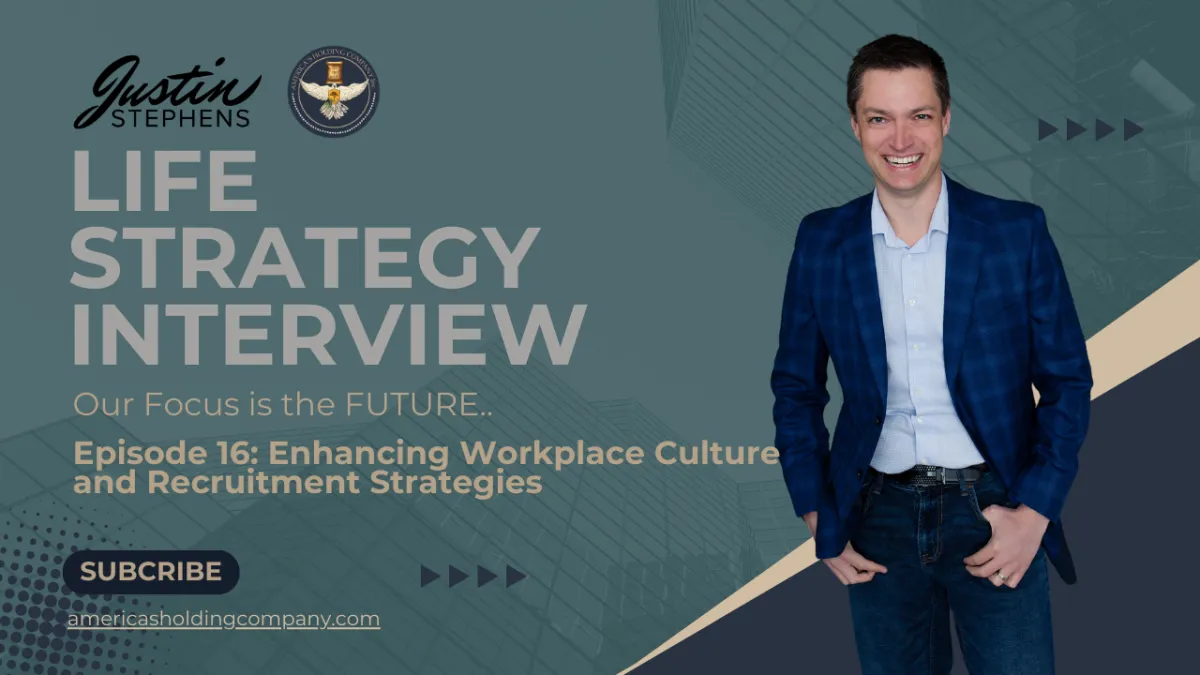The Prospecting Done For You Blog

Episode 16 - Enhancing Workplace Culture and Recruitment Strategies with Abel Johnson
Life Strategy Insights from Abel Johnson
Life with Justin Stephens: Building a Better Workplace Culture
In this blog post, we explore 'Life with Justin Stephens' as he engages in a meaningful conversation with Abel Johnson from Hidden Talent about the importance of workplace culture and effective hiring practices. Together, they share insights and strategies for creating a positive environment that attracts the right talent.
Table of Contents
Paving the Path: Understanding Workplace Culture
In the journey of creating a successful business, the foundation often lies in understanding workplace culture. Workplace culture encompasses the values, beliefs, and behaviors that shape how employees interact and work together. It's not just about perks like ping pong tables or free snacks; it’s about fostering an environment where employees feel valued and engaged. This section delves deeper into the significance of cultivating a positive workplace culture.
The Heart of Culture
Culture is the heart of any organization. It influences employee satisfaction, retention, and productivity. When employees feel aligned with the company's values, they are more likely to be engaged and committed. This symbiotic relationship between a positive culture and employee performance cannot be overstated.
Key Elements of Workplace Culture
Communication: Open and honest communication fosters trust and transparency.
Recognition: Acknowledging employee contributions boosts morale and motivation.
Inclusivity: A diverse and inclusive environment encourages different perspectives and innovation.
Work-Life Balance: Supporting employees in achieving a healthy balance promotes well-being and productivity.
Recruitment: Finding the Right Fit
Recruitment is more than just filling a position; it’s about finding individuals who align with the company's culture. A thorough understanding of the desired culture can guide the recruitment process, ensuring that new hires will contribute positively to the workplace environment.
Strategies for Effective Recruitment
Define Your Culture: Clearly articulate what your company stands for and the type of environment you offer.
Craft Authentic Job Descriptions: Use job descriptions to showcase your culture, values, and what makes your organization unique.
Engage with Candidates: Create a welcoming recruitment process that allows candidates to experience your culture firsthand.
Leverage Employee Testimonials: Current employees can provide valuable insights into the company culture, helping attract like-minded candidates.
The Experience of Job Seekers
Job seekers today are savvy; they do their research before applying. The experience they have during the recruitment process can significantly affect their perception of the company. A positive experience can turn potential candidates into enthusiastic applicants, while a negative experience can tarnish a company’s reputation.
Enhancing the Job Seeker Experience
Timely Communication: Regular updates throughout the recruitment process can alleviate anxiety and build trust.
Feedback Mechanisms: Providing constructive feedback to candidates, regardless of the outcome, demonstrates respect and professionalism.
Streamlined Processes: Simplifying the application and interview process can make a significant difference in a job seeker's experience.
Bridging the Gap: Employers and Job Seekers
To effectively bridge the gap between employers and job seekers, both parties must engage in open dialogue. Employers need to understand the expectations and experiences of job seekers, while job seekers should be educated about the realities of the job market.
Creating Mutual Understanding
Workshops and Seminars: Offering training sessions for employers on the job seeker experience can help them understand the challenges candidates face.
Encouraging Feedback: Employers should actively seek feedback from candidates about their recruitment experiences.
Networking Opportunities: Facilitate networking events where employers and job seekers can interact in a casual setting.
In 'Life with Justin Stephens,' the focus is on transforming the recruitment process into a more positive experience for both employers and job seekers. Through education and transparency, the goal is to create a more connected and understanding workforce that thrives on mutual respect and shared values.
Marketing Your Business to Attract Talent
Marketing your business effectively is crucial for attracting the right talent. It's not just about posting job ads; it's about showcasing your company culture and values in a way that resonates with potential employees. Understanding what drives candidates to apply can significantly enhance your recruitment strategy.
Understanding Candidate Motivations
Every candidate has unique motivations for seeking a new job. Some may prioritize salary, while others might be looking for flexibility or a better work-life balance. As an employer, it's essential to recognize these varying motivations and align your marketing efforts accordingly.
Strategies to Market Effectively
Highlight Your Culture: Use social media and your website to give insights into your workplace culture. Share employee stories, testimonials, and day-in-the-life videos.
Be Transparent: Clearly communicate job expectations, responsibilities, and potential career paths. Transparency builds trust with candidates.
Utilize Employee Networks: Encourage current employees to share job postings within their networks. They can serve as authentic ambassadors for your brand.
Vulnerability in the Hiring Process
Vulnerability in the hiring process can lead to more authentic interactions between employers and candidates. It involves being open about your company's challenges and the realities of the job.
Creating an Honest Job Description
Job descriptions should reflect the true nature of the role and the company. This includes being upfront about salary ranges, expectations, and company culture. Being vulnerable in this way can help attract candidates who are genuinely interested in your organization.
Key Areas for Vulnerability
Salary Transparency: Listing salary ranges can attract candidates who are genuinely interested, saving time for both parties.
Discuss Company Challenges: Openly talk about any recent changes or challenges your company has faced. This can foster trust and understanding.
Encourage Questions: Allow candidates to ask tough questions during interviews. This openness can lead to better alignment between candidate expectations and job reality.
The Art of Hiring
The hiring process is as much an art as it is a science. It requires intuition, empathy, and a keen understanding of both the role and the candidate.
Crafting the Perfect Interview
Interviews should be designed to assess not only skills but also cultural fit. This can be achieved through behavioral questions and situational assessments that reflect real challenges faced in the role.
Effective Interview Techniques
Behavioral Questions: Ask candidates how they handled past challenges to gauge their problem-solving skills and cultural fit.
Scenario-Based Assessments: Present hypothetical situations related to the job and assess the candidate’s approach and reasoning.
Involve Team Members: Include future colleagues in the interview process to provide different perspectives and enhance team dynamics.
Consultancy for Small Businesses
Small businesses often face unique challenges in hiring. They may not have the resources of larger companies but can still create effective hiring strategies.
Building a Sustainable Hiring Strategy
Consultancy can help small businesses develop a robust hiring process that is tailored to their specific needs. This includes creating structured hiring practices and providing training for current staff involved in the hiring process.
Key Consultancy Services
Hiring Audits: Assess current hiring practices to identify strengths and areas for improvement.
Training Programs: Develop training for hiring managers to enhance their interviewing and selection skills.
Ongoing Support: Provide continuous support and resources as the business grows and evolves.
Final Thoughts on Hiring Strategies
Effective hiring strategies require a combination of marketing, vulnerability, and a deep understanding of both the candidate and the role. By prioritizing these elements, businesses can create a more inviting and productive hiring process.
Looking Ahead
As the job market continues to evolve, organizations must remain adaptable. Embracing new hiring practices and fostering a culture of openness will not only attract top talent but also enhance overall employee satisfaction.
Embrace the Change
Stay Informed: Keep up with industry trends and adjust your hiring strategies accordingly.
Foster Relationships: Build long-term relationships with candidates, even those who may not be hired immediately.
Invest in Your Brand: Continuously work on building a strong employer brand that reflects your company's values and culture.
FAQ
What should I include in a job description to attract the right candidates?
Focus on clarity regarding the role, expectations, salary range, and company culture. Authenticity is key.
How can I make my hiring process more efficient?
Streamline your interview process, utilize technology for scheduling, and ensure clear communication with candidates throughout.
Why is vulnerability important in hiring?
Being vulnerable allows for honest conversations that can lead to a better cultural fit and long-term success for both the employer and the employee.








